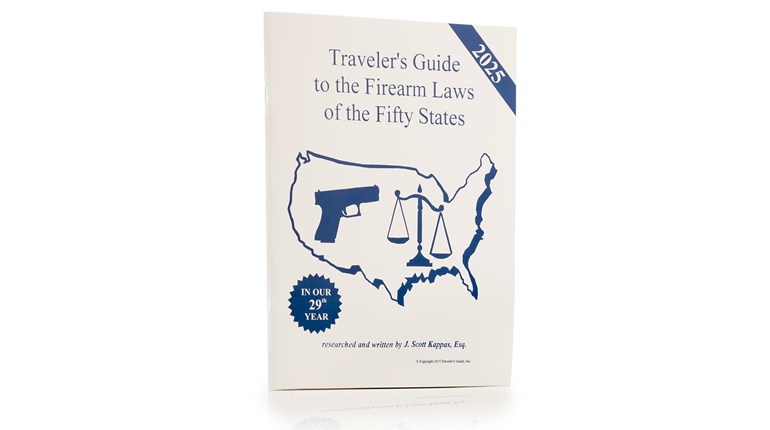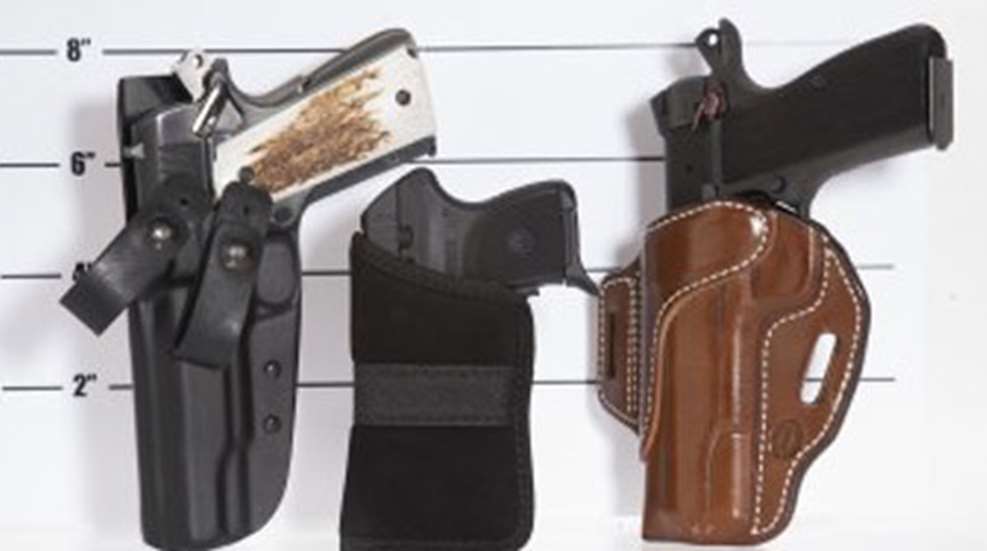
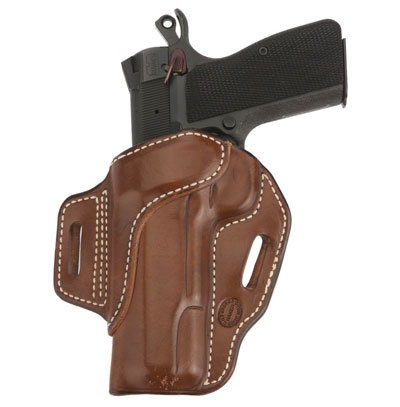
While it may contradict the opinions of some of my fellow firearm journalists, in a previous installment I made a point to discuss why there is no ideal handgun capable of satisfying the caliber, capacity and comfort needs of everyone. Similarly, when it comes to selecting a holster for concealed carry, there are those who advocate a similar approach: carrying the same pistol daily and utilizing a single carry and placement method, without variation.
Granted, such a philosophy could benefit the development of muscle memory and draw speed. However, I view it as somewhat impractical and unrealistic, because it doesn't acknowledge a crucial yet often overlooked factor regarding seasonal wardrobe changes. Taking the time to research the most common types of holsters and their key design elements will maximize concealability, while simultaneously addressing the needs and limitations associated with a physical disability.
Exterior Strong-side Hip Holster
One of the most prolific types of holsters, this model positions the pistol on the shooting-hand side of the body, generally between the point of the hip and the kidney. Different styles include the belt slide, paddle and pancake, the features of which typically include a single channel, a concave-shaped flange or a pair of loops/slots for attachment to a belt. While some exterior strong-side belt holsters orient the pistol to ride in a straight up-and-down position—also referred to as a zero-cant position—others hold the pistol in a 15-degree forward angle, commonly referred to as an FBI cant. If forced to choose between an exterior strong-side holster with an FBI cant or a zero-cant model for use with a wheelchair, the FBI cant would win hands down. Having said that, however, I can tell you from experience a custom-made model with a 25-degree cant is optimal for use in a wheelchair. Best of all, there are plenty of custom leatherworkers willing to accommodate such as request.
In addition to their popularity, exterior strong-side hip holsters offer a balanced blend of access, concealment and retention, especially for those who utilize mobility aids such as crutches, a walker or a cane. Someone wheelchair bound, like me, may find some disadvantages. Due to its location, presenting the pistol from this type of holster requires leaning toward your off-gun side during the draw stroke, even when using a holster with an FBI cant. The side of my pistol has been known to rake against an occasional armrest while transferring from my wheelchair to my desk.
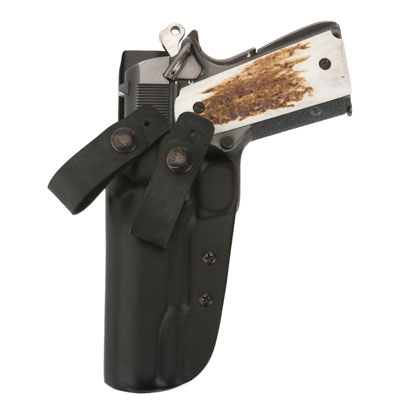
The inside-the-waistband holster is a hybrid version of a strong-side holster that is designed to carry a pistol inside the waistband of trousers instead of on the exterior of a belt. Most of these holsters feature loops that encircle the belt to hold the holster in place. Although such a design offers the maximum in concealment, this type of holster often requires wearing trousers one size larger than normal to accommodate it comfortably.
Typically constructed of extra-sturdy horsehide to facilitate its close proximity to the body, some inside-the-waistband holsters contain a metal reinforcement around the holster's mouth and below the beltline to prevent collapse after drawing the pistol (although I've found Kydex versions great for this reason, too). Given the enhanced degree of concealability they offer, since the lower part of the holster and pistol are hidden inside the pants, inside-the-waistband holsters make it possible to successfully conceal full-size duty pistols with a waist-length cover garment, such as a bomber jacket. However, this carry method isn't without its drawbacks, since it regularly subjects the pistol to year-round exposure to perspiration—twice as much during summer months, which makes keeping your pistol regularly wiped down with oil paramount.
Despite the popularity of exterior strong-side holsters, I often opt for an inside-the-waistband holster instead. The way it fits snugly to the body prevents my pistol from being unintentionally knocked around as I transfer from my scooter to my office chair and vice versa.
Crossdraw Holsters
Designed to be worn on the support side with the pistol butt facing forward, the crossdraw holster requires reaching across the body with the firing hand to draw the pistol. The location provides comfort and ease of access—even when seated—making it another model worthy of consideration for those who are wheelchair bound. Regarding drawbacks, there are a few, especially for people with short arms or substantial girth, making it difficult to reach across their midsection during the draw stroke. Given the fact this design positions a pistol's grip within easy reach of a potential threat also makes weapon retention a chief concern. A model containing a built-in retention strap, however, could provide a simple solution.
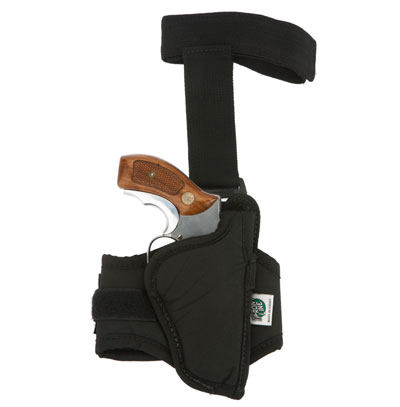
What some view as a byproduct born out of compromise (sacrificing easy access for better concealment), I see ankle holsters a source of opportunity—especially for people who sit for long periods, the wheelchair bound or for those times when the mercury is too high to get away with wearing a cover garment over a traditional holster without arousing suspicion. Designed to carry a small handgun just above the ankle by way of a large cuff or multiple straps encircling the lower leg, ankle holsters position a pistol muzzle down and are often placed on the inside of the support-side leg. Although they can be used for a primary handgun, an ankle holster is best used with small, lightweight backup-style handguns, such as snub-nose revolvers or pocket pistols.
What ankle holsters offer in concealment, they lack in speed—well, sort of. Accessing the pistol requires a somewhat complex series of movements, including bending down or lifting your leg, raising your pants leg and disengaging any built-in retention device prior to beginning your draw stroke. So, for those who suffer from limited range of motion or those who may be unable to do so when seconds count, you might want to contemplate another carry method. However, those with limited mobility or confined to a wheelchair may find an ankle holster appealing. One final note: Make sure your pants legs are sufficiently loose in order to facilitate easy access to your pistol without binding on the holster.
Carry a handgun long enough and you will soon see the advantages a pocket pistol can offer, especially in situations where carrying a full-size pistol may be not be possible. As such, it's easy to see why people eventually come to regard a pocket holster as a perfect means of concealed carry when utmost discretion is needed. After all, the act of dropping a pocket pistol into a coat or pants pocket when as you head out the door to make that quick trip to grab Friday-night takeout is equally as simple as grabbing your wallet.
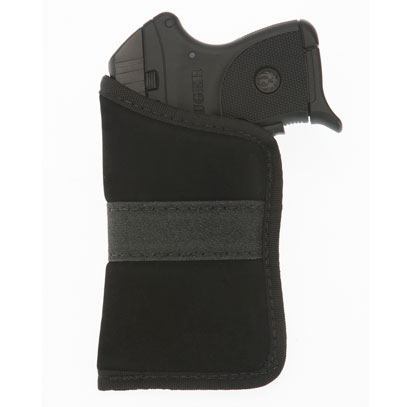
As to the benefits of a pocket holster, as opposed to carrying without one, there are a few: A pistol carried without one will often shift as you move, which forces the butt downward and places it at an incorrect angle when you attempt to draw it. Such a practice not only makes for a sloppy presentation, it could also have deadly consequences.
In addition to orienting the pistol so its butt remains in a consistent and easily accessible position, a pocket holster also prevents the handgun from printing against clothing by breaking up the telltale outline through the pocket. They also provide tremendous convenience and versatility due to their effectiveness of concealment with virtually any type of clothing.
From a tactical standpoint, a pocket holster enables you to have your hand on your pistol at the first hint of danger, without bringing attention to yourself and those around you. Given their ability to be utilized in a variety of garments and the convenience and versatility they offer, I view these holsters as an ideal means of concealment for anyone with a disability. Should you become separated from your primary sidearm, either as a result of a struggle or the muzzle clipping the edge of your armrest or steering column during presentation, a pocket holster provides quick access for your "always gun."
Shoulder Holsters
Glamourized in movies and TV programs, the shoulder holster has seen tremendous advancements in design and popularity since their original development more than a century ago. Consisting of a harness encircling both shoulders and suspending a handgun from beneath the armpit of the support hand, today's shoulder holsters are available in a wide variety of models that orient a pistol in several ways—offering the wearer great versatility—thereby making shoulder holsters ideal for someone who is seated for long periods of time. Perhaps that is why they are popular with law enforcement/military pilots and armored-vehicle personnel, along with members of a security details assigned to vehicles. Therefore, it is understandable why shoulder holsters would benefit the physical disabled, especially those who are wheelchair bound. Unlike a strong-side belt holster, drawing from a shoulder holster is much easier when seated.
In addition, from a tactical standpoint, the act of calmly folding your arms at the first hint of danger to enable your firing hand to access a shoulder-holstered pistol draws a lot less attention (not to mention requires tremendously less effort) than drawing from a strong-side hip holster. They are also one of the only types of holsters that don't require use of a belt—which could be advantageous for someone with limited fine motor skills or those with lumbar spine injuries.
Models that combine magazine pouches/ammo carriers with a holster comprise a complete shoulder system—a concealed-carry complement comprising a single piece of gear, as opposed to multiple pieces that need individual placement on a belt. Also, since a shoulder holster carries the pistol beneath the support-side arm, the nature of its design makes it one of the easiest holsters to draw from with your weak hand should you become injured during a gunfight. However, be sure to raise your nondominant arm during the draw to avoid sweeping yourself with the muzzle.
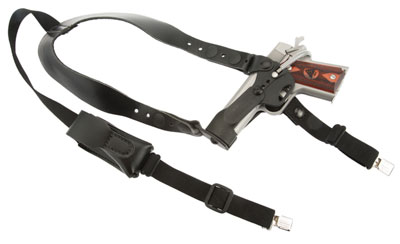
When I first began carrying concealed, it took me some time to settle on the type of firearm that offered a balance of comfort and practicality. (I even made a shoulder holster of my own design to use while at Gunsite many years ago.) The one long-standing constant was my use of a shoulder holster. No matter if I was relying on my crutches or my wheelchair, a shoulder holster provided an optimal level of quick access, concealment and comfort. As time passed and birthdays passed, it forced me to restrict my use of shoulder holsters in lieu of alternative methods of carry as a result of developing a duke's mixture of arthritis and degenerative-disk disease in my spine. Nonetheless, I still find myself turning to shoulder holsters these days—especially during winter and fall months when jackets are worn. Although their service is primarily geared more toward short-term use, such as an impromptu decision to catch a movie or run an errand, I take comfort in knowing a shoulder holster puts everything I need to defend myself in a single piece of gear that is easy to don and quick to access when seconds count.
Lastly, pistol-packing females naturally gravitate toward shoulder holsters because most hip holsters are designed for men, and as a result they ride too high on a woman's body. Along similar lines, selecting a shoulder holster serves a practical as well as a stylish vein in that it saves them from having to wear manly looking pants that contain belt loops wide enough to accommodate the type of belt needed to comfortably retain a handgun, holster and spare-ammunition pouch. According to an article written by Massad Ayoob in the August 1999 issue of Guns Magazine, women also have a genetic advantage when it comes to shoulder holsters. Unlike men who can have difficulty reaching across their chest to grip a shoulder-holstered handgun, for some reason women's arms tend to be more limber enabling them to reach farther toward their support-side armpit. It turns out holster designer/quick-draw artist Chic Gaylord brought this phenomenon to light back in his 1960 book, "Handgunner's Guide." It also served as the basis for his Dynamite shoulder Rig, which was originally designed for policewomen.
In the next installment, I'll discuss alternative methods of concealment.













